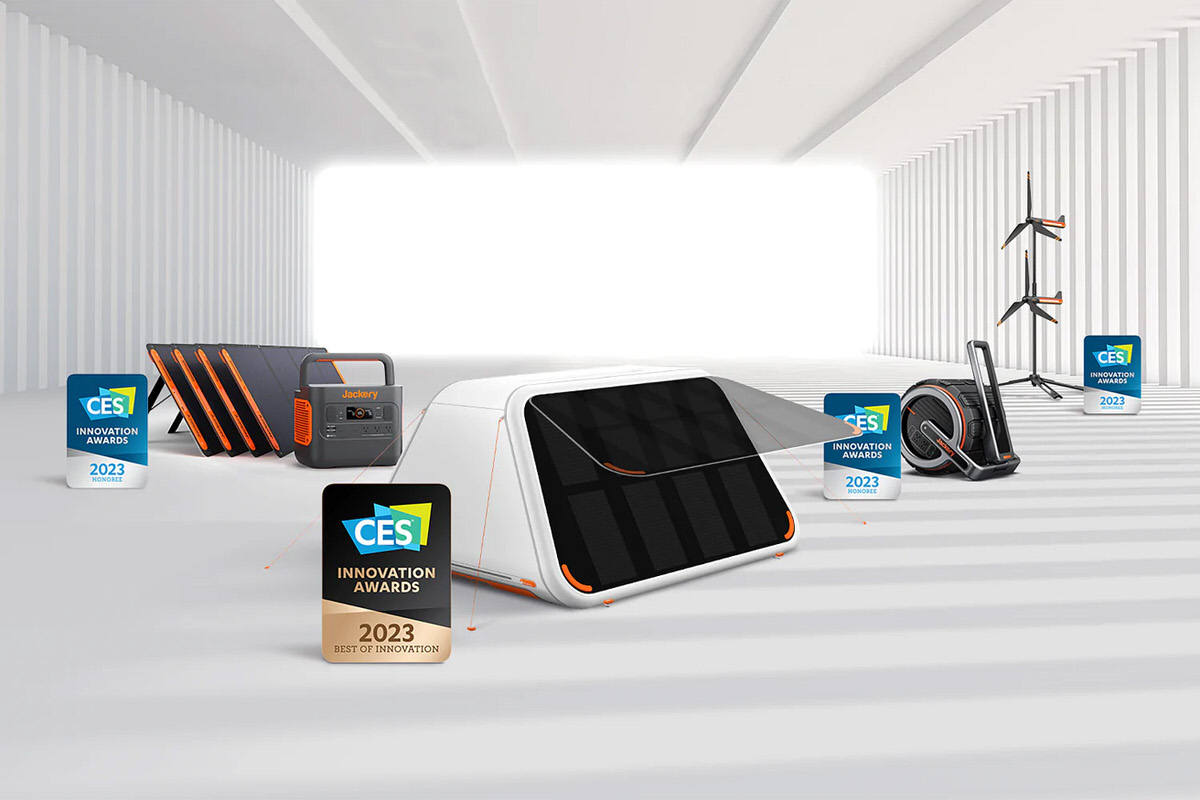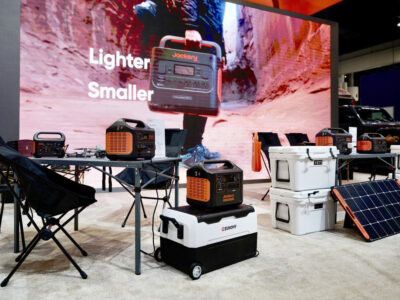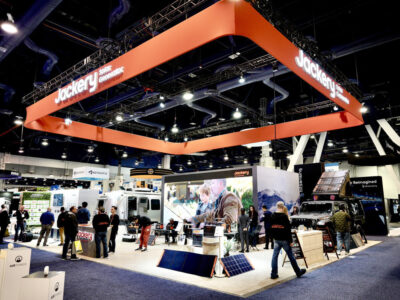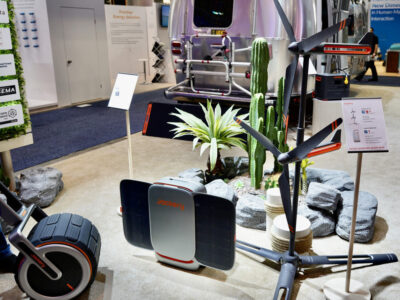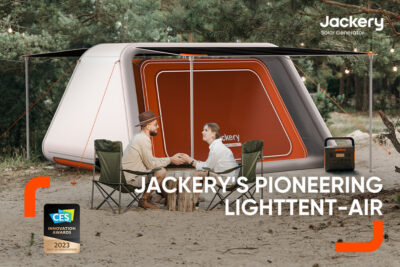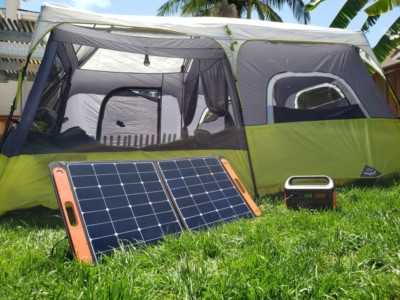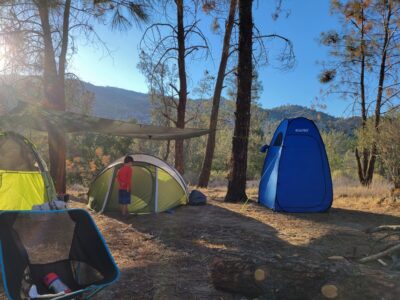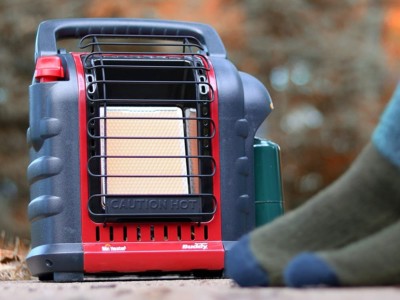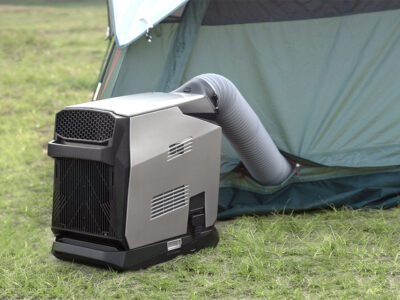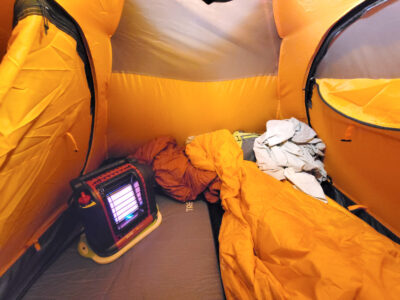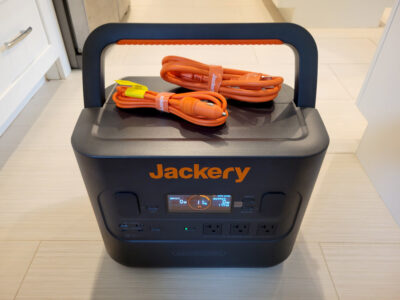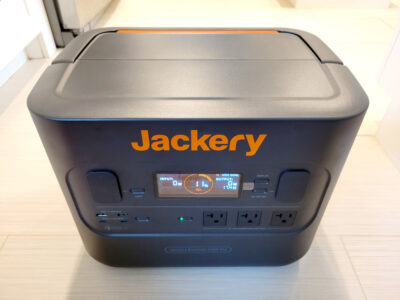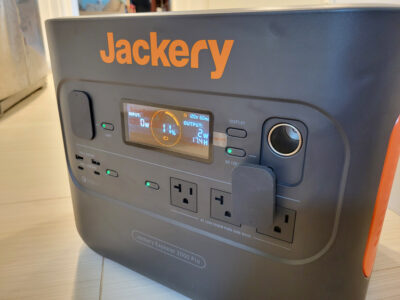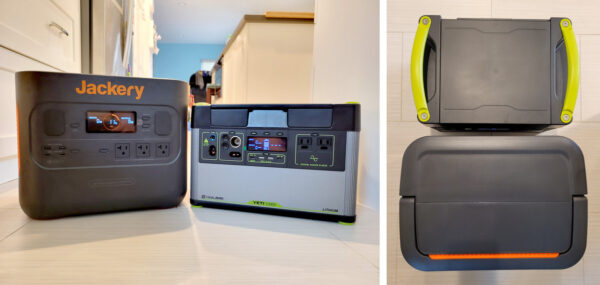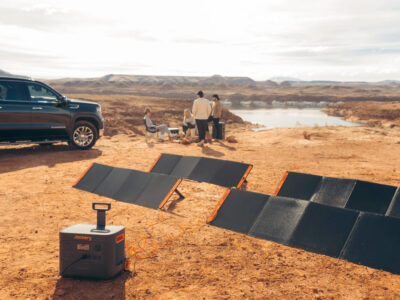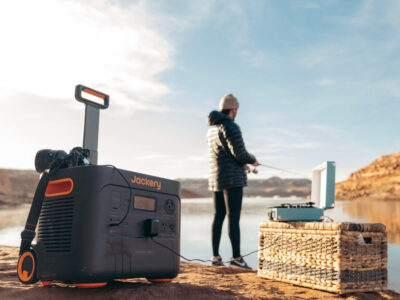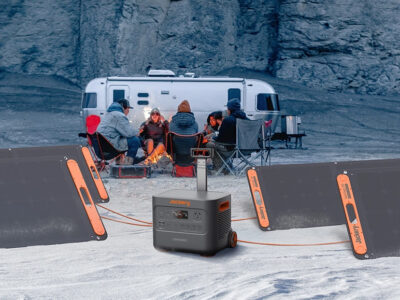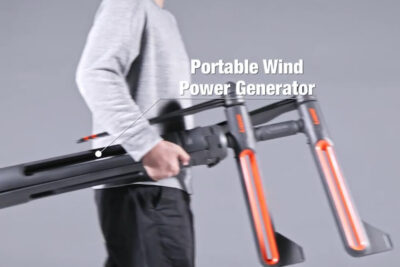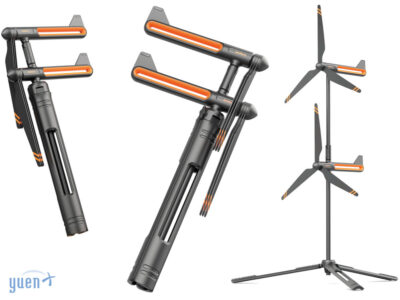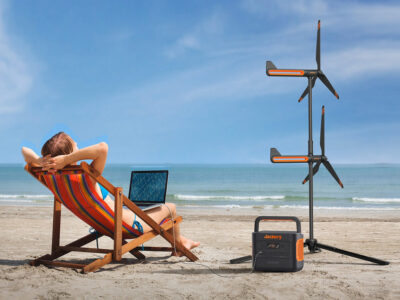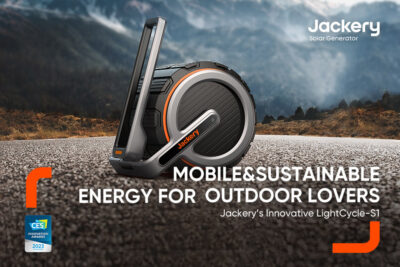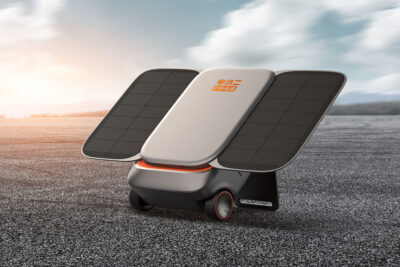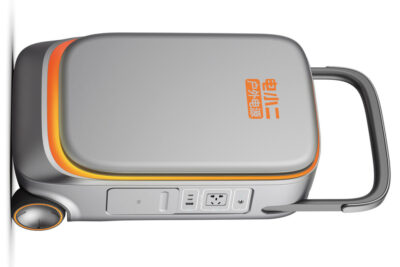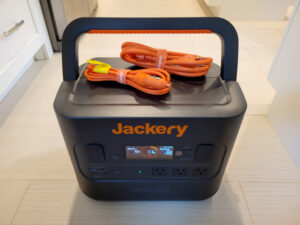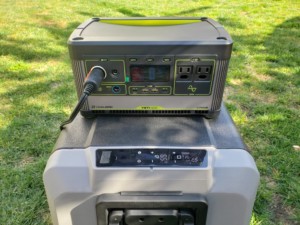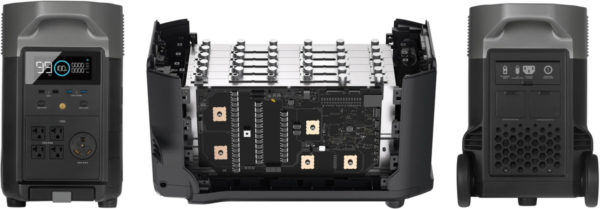Contents
CES 2023 Awards for Jackery
Jackery showcased some products at this year’s Consumer Electronics Show (CES) for which it had won multiple awards. CES, according to the organization’s website, “is the most influential tech event in the world – the proving ground for breakthrough technologies and global innovators.” Many of the best, future technologies had made their debut there, although whether they come to market is another story… Jackery is one of the top power station manufacturers in the World with a success story that has made them one of the rising stars in the industry, competing against well-known brands like Goal Zero, EcoFlow, and Bluetti.
The CES Innovation Awards is a prestigious program that companies compete against across 28 product categories, and Jackery won a “Best of Innovation” for its LightTent-AIR, an inflatable tent with built-in, photovoltaic (PV) solar cells to generate up to 1,200W of energy using thin and flexible gallium arsenide (GaAs) technology. As someone who camps, backpacks, and boondocks/overlands a LOT, I have very mixed feelings about that.
The company had also received Innovation honors for its flagship Solar Generator Explorer 2000 Pro (a power station with solar panel combination), Air-W portable wind-power generator, and LightCycle-S1 wheeled 3,500Wh battery with 3,500W output capacity. Also featured were the DX Power-Space Pro (a luggage-style power station with built-in solar panels) and Solar Generator Explorer 3000 Pro. Not much information is yet known about the products besides the Solar Generator products. I had, in fact, written a review for the Jackery Explorer 2000 Pro two months ago.
In this article, we will look at the:
- LightTent-AIR / Air-W / LightCycle-S1 / DX Power-Space Pro
- Solar Generator Explorer 2000 Pro / Solar Generator Explorer 3000 Pro
LightTent-AIR
The winner of the CES 2023 “Best of Innovation” Award attempts to take camping to a new level. Inflatable tents are not new, but where the LightTent-AIR shines is its marriage with Jackery’s experience in harnessing the sun’s energy: by integrating thin, flexible (GaAS) solar panels into its adjustable canopy for 24/7 power. Think of light versions of its foldable SolarSaga panels placed on top of your tent. Wonderful! Of course, a tent must be both waterproof and windproof to be useful for at least three of the four seasons, and the company coated the fabric with flame-retardant PVC that also helps to retain heat.
The GaAS solar panels can capture up to 1,200W of power to charge the tent’s “built-in electricity storage modules” for use at night. Imagine lighting up the whole campsite throughout the evening and running multiple fans to circulate the air inside while you sleep — something I had already been doing with portable power stations from Goal Zero, Jackery, EcoFlow, and other brands, but now from the tent itself. Not much is known about how many Watt-hours (Wh) the tent’s storage modules can hold. I have reached out to the company and will update when I receive an answer.
How much energy a battery can store is measured in Wh (Watt-hours), and how much power is used or produced in W (Watts).
LightTent-AIR has a minimalist look and was a prototype at the CES. It sported a white and orange color scheme to match its other products. Once inflated, its structure is self-supporting and sturdy, does not require any tent poles (except to prop up the canopy), and fits 4-5 persons, depending on how comfortable you want to be. As a general rule, I reduce the body count by one when looking at tents — a tent rated for 5 persons is comfortable for four adults, a 4-person one for just three, and so on. Alternate each person’s orientation, and you could fit 5 into a 5-person, but who wants to have a person’s feet by their head? I am curious to see what different sizes Jackery will provide for its LightTent-AIR.
Now, I mentioned earlier that I have mixed feelings about this product.
How reliable can inflatable tents be? How long will they last and how puncture-resistant are they? I would suggest to always check the ground for rocks and sticks — anything that could poke a hole — and throw a tarp or footprint underneath the tent for additional protection. How will they stand up against the elements — snow and strong winds in particular? How is the tent inflated? If it uses a built-in pump, how reliable will it be? Nothing worse than finding yourself in the middle of a camping trip with a tent leaking air. I would still bring a backup, traditional tent… just in case!
Since solar generation requires the tent to be out in the sun for maximum energy capture, how will the temperature inside be? Will it be too warm? Thankfully, the canopy and door can be opened to allow for maximum air flow, but have you ever tried to sit on an inflatable mattress after it had been in the sun for some time? Yup, air heats up in the sun, and so the walls may be a bit warm to the touch. That might be a good thing for cold-weather camping with the heat-insulating properties, but I do not expect it to hold well in freezing temperatures because larger rooms take more heat to keep warm. In other words, they get cold faster than smaller structures.
Speaking of cold weather, the Mr. Heater Buddy was awesome when we took it to Yosemite during Thanksgiving 2022! Just be sure to keep it away from the tent’s walls! On the other hand, if the tent gets too hot, one could always throw in a portable air conditioner, like the EcoFlow Wave, that changed the game for our summer camping trips!
I am excited about the LightTent-AIR and can see why CES gave the award, but how it will do in practice in the real world remains to be seen.
Solar Generator Explorer 2000 Pro
The Explorer 2000 Pro is one of Jackery’s flagship power stations with a 2,160Wh battery capacity made by BAK Battery. It could, for example, power a 60W laptop continuously for up to 36 hours, a CPAP machine for 32-72 hours, and a car freezer for 4 or more days, depending on ambient temperature. An equally important pair of numbers to look at is the 2,200W continuous and 4,400W peak output rating with a pure sine wave AC inverter. If those numbers do not make sense to you, do not worry. I go over them in detail in my review of the Explorer 2000 Pro. Essentially, 2,200W allows you to run virtually anything, including a miter saw, coffee machine, projector, pressure cooker, microwave, portable air conditioner, or even a Starlink satellite dish.
How much energy a battery can store is measured in Wh (Watt-hours), and how much power is used or produced in W (Watts).
“Solar Generator” is Jackery’s term used for a product offering that combines its Explorer power station with one or more SolarSaga solar panels.
The Explorer 2000 Pro, as detailed in my review, has a new, modern look similar to the Goal Zero Yeti 500x, and offers fast-charging capability from empty to full in as little as 2 hours from the AC wall (120V @ 15A at 1,800W) or as fast as 2.5 hours with an array of solar panels (60V @ 24A at 1,400W max) and optional Jackery parallel cable. It slowed down rapid-charging once nearing 80% for safety reasons. The fast charging significantly outperformed the aging Goal Zero Yeti X series, but was on par with the 1,800W AC (120V) or 1,600W solar input of the EcoFlow Delta Pro. One should note that at 240V, the Delta Pro could charge at a whopping 3,000W AC input.
It uses Lithium-Ion Nickel Manganese Cobalt (NMC), although there is a debate over whether NMC or Lithium Iron Phosphate (LiFePO4) is better. There are pros and cons to both battery chemistries.
A big bummer with the new Explorer 2000 Pro was the change in the 8mm connector. Where the older Jackery Explorers and SolarSaga solar panels used the standard DC7909 plug (7.9mm outer, 0.9mm inner diameters), the 2021 and newer models now use the slightly larger DC8020 (8.0mm outer, 2.0mm inner). The center pin was now thicker. Why the change? To accommodate for the increased fast-charging current. That also meant that an adapter (free from Jackery, if one was not included, or buy SolarEnz) was needed for the older products to be used with the newer ones (or even some Goal Zero items). Yes, both companies’ DC7909 connectors were similar enough for many of their goods to be used interchangeably although the barrel design was not an exact match. Jackery moved the DC8020 input – which their new solar panels use – to the rear alongside the AC port.
Jackery’s Explorers are excellent, stand-alone power stations, and coupled with the company’s excellent customer service, makes for compelling products that remain a solid recommendation.
Explorer 3000 Pro
Offering 3,024Wh of capacity and 3,000W of output is Jackery’s largest battery power station to date: the Explorer 3000 Pro. The company claimed a full charge from empty in as little as 2.5 hours from the AC wall or 3-4 hours with six SolarSaga 200W solar panels. A representative stated that it will be the lightest battery in its class and is expected to go on sale in February 2023 for around $3,000. There will also be a “Solar Generator” package available that combines the Explorer with one or more SolarSaga panels.
Air-W
EcoFlow in early 2022 announced its Wind Turbine that promised power generation from the wind. That had me very excited in the EF Delta Pro review for situations when the sun was not quite available, such as rainy, overcast, or snowy days, but a year later, I still had not seen it made available for purchase. Bummer! Will Jackery pull through and release its Air-W? We shall see!
The Air-W is a three-bladed wind-power generator that is mounted on a sturdy tripod with a wide base. It weighs a portable 11 lbs (5kg), and Jackery claims a combined power output of up to 200W from its dual-motor mini turbines that can swivel around to capture maximum air flow. A staggered layout of upper and lower blades additionally provides for flexibility in height. They have a black-and-orange color scheme like the Explorer and SolarSaga product lines.
With an IP67 rating that offers one of the highest levels of protection against both dust and water, it can be submerged down to 3.3′ (1m) of freshwater for up to 30 minutes. IP stands for “Ingress Protection”, the first number (6) refers to solid objects, and the second (7) to liquids. The thermoplastic carbon-fiber composite tripod has built-in, foldable post nails for better reinforcement and stability against strong winds.
The Air-W won the Red Dot: Best of the Best 2022 award, and power will likely be sent through a DC8020 connector cable to recharge its Explorer power stations with. Attach a DC8020-to-DC7909, DC8020-to-MC4, or DC8020-to-APP adapter, and you could (in theory) use the Air-W with batteries made by competitors like Goal Zero, EcoFlow, and Bluetti.
LightCycle-S1
The LightCycle-S1 is quite an interesting design with an old idea: generating power through kinetic energy by towing it around, then storing it in its built-in battery pack — most likely, Lithium-ion Nickel Manganese Cobalt (NMC) for weight saving over Lithium-ion LiFePO4. It reminds me of a youth where pedaling on a bicycle generated power for the headlight, or — as the Toyota Sienna Hybrid, Tesla, and many modern vehicles do — recover energy through regenerative braking when the moving vehicle slows down.
Jackery stated that its 3,500Wh battery can output 3,500W. That’s quite the capacity! At first, I thought that the company was going to announce a new Explorer 3500 Pro and would make it the company’s heaviest power station yet, but the LightCycle-S1 was unveiled instead.
How much energy a battery can store is measured in Wh (Watt-hours), and how much power is used or produced in W (Watts).
I see very limited use for this new product and will most likely be more appealing to the commercial customers who need maximum power on-the-road. However, I would be quite concerned about how it would hold against the elements like dust, dirt, mud, and water. How clean could it stay? How would it handle rocky terrain? The company did state that it is shock-resistant.
Jackery claims full charge from empty after towing the LightCycle-S1 for 125 miles (200km ).
DX Power-Space Pro
A suitcase-looking product is the DX Power-Space Pro that combines solar panels with a 6,000Wh battery and can output 3,000W, though another Jackery representative claimed just a 4,000Wh capacity. It can be hauled around with a trolley and pulley design — like a luggage bag — and have the two side solar panels unfolded for charging. This makes it more convenient than hauling around a separate power station and solar panel and should appeal to the road warrior.
Note that the large battery capacity (6,000Wh or 4,000Wh, depending on who you asked) will NOT allow it to be checked in or carried onto an airplane. United Airlines, for example, allows for a 300Wh removable battery and Southwest Airlines is more restrictive at 160Wh. Lithium-ion batteries are known to be volatile, and the higher their capacity, the more risky they are. Check with the airlines, TSA, and FAA for more details.
There was no additional information available on what size the solar panels were, but I would imagine each to be rated at least 100W. DX Power-Space Pro won the Red Dot: Best of the Best 2022 award.
Final Thoughts
Jackery and EcoFlow have been debuting new product types in recent years in an effort to expand their power station and solar panel product portfolio. EcoFlow, for example, created their Wave portable air conditioner while announcing Wind Turbine, Smart (Gas) Generator, Solar Tracker, Remote Control, and EV Charger with their Delta Pro debut. They even said that support for roof top solar panels was coming to shore up their home backup power integration offering. Goal Zero, the global market leader in portable power storage and generation, had integrated their Yeti products into the home with the Home Integration Kit for some time. I am excited to see what the future holds as more companies come up with new, innovative ideas for off-the-grid, green energy. Competition is good for the consumers!
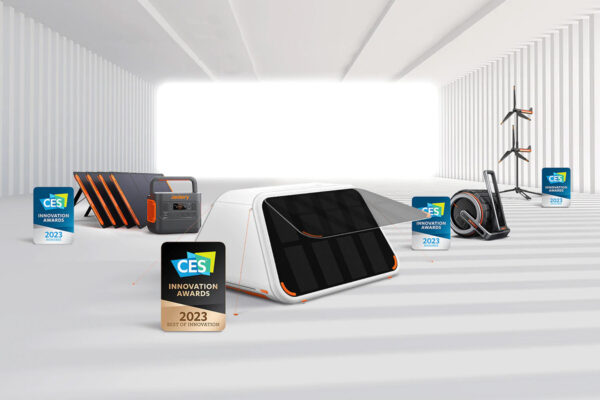
CES 2023 Innovation Awards: Solar Generator Explorer 2000 Pro, LightTent-AIR, LightCycle-S1, Air-W /Jackery
Where To Buy
See Jackery.com for availability on the Explorer 2000 Pro, LightTent-AIR, Air-W, LightCycle-S1, and DX Power-Space Pro.
- Jackery
- Goal Zero Yeti 500x (Goal Zero | Amazon) – See our Review
- EcoFlow Delta Pro – See our Review / Max / Mini
- EcoFlow Wave Portable Air Conditioner – See our Review
- Mr. Heater Buddy – See our Review
Related Posts
- Power Generators: Gas vs Propane vs Battery Station (and Solar)
- Ultimate Reference: Power Station Comparison
- Reviews
- Jackery Explorer 2000 Pro / Explorer 1000 / Explorer 300
- Goal Zero vs Jackery: Yeti 1000 Core vs 1000X vs Explorer 1000
- Goal Zero Yeti 1500x / Yeti 1000x / Yeti 1000 Core / Yeti 500x
- EcoFlow Delta Pro LiFePO4
- EcoFlow 220W Bifacial Solar Panel
- Bluetti EB70S LiFePO4
- BigBlue Cellpowa500 LiFePO4
- Rockpals 500W / nrgGo 400
- Quick Look
- Announcements
- EcoFlow Wave Portable Air Conditioner
- Toyota Sienna (2021-2023) Favorite Accessories, Modifications, Tips – Fourth (4th) Generation Sienna
Other Useful Topics
Power Station Comparison
Check it out!
Ultimate Reference: Power Station Comparison – We summarized the specifications of many of the power stations we had come across or reviewed all in one place.
Gas/Propane Generators vs Battery Power Stations
In July 2020, I wrote about this topic after many asked what their differences were. In short, gas/propane generators can run virtually forever but are loud, dirty, and potentially quite dangerous. Battery power stations, on the other hand, are more portable, silent, less volatile, and can be operated indoor, but depend on external power (like solar) to recharge. Where gas/propane are used to GENERATE electricity, batteries STORE them for later use. Personally, I am a fan of the latter because they are so easy to carry around and are safer to use.
Who is Jackery?
According to the company, its name was derived from “Jacket” and “Battery” as a homage to its Apple jacket battery manufacturing roots. The company was founded in 2012 by a former Apple battery engineer and claims to have “launched the [World’s] first… Lithium Portable Power Station” three years later. It had partnered with Honda to brand the Japanese namesake onto a variety of battery products.
Battery Technology and Safety
Goal Zero debuted with Lead-Acid batteries that were bulky and heavy. Today’s devices use Lithium-ion — commonly Nickel Manganese Cobalt (NCM) or Lithium Iron Phosphate (LiFePO4 / LFP) chemistries — for more power in a smaller, lighter package. NMC, however, is more volatile than LiFePO4 and becomes riskier as more cells are packed together. Goal Zero and Jackery used NMC for some time whereas EcoFlow and Bluetti use LiFePO4. Jackery launched its first LiFePO4 model in mid-June 2023 and Goal Zero in October that year.
- How much energy a battery can store is measured in Wh (Watt-hours), and how much power is used or produced in W (Watts)
- The higher the Watt-hour (Wh) capacity rating, the more dangerous the battery could become if not handled right
The quality of the battery cells and the BMS (Battery Management System) are crucial for safety.
Cell Manufacturers
Battery cells made by LG and Sony are among the best in the hobbyist world as are Sanyo/Panasonic and Samsung. Goal Zero uses LG. Jackery also uses LG or BAK (a leading Chinese brand). EcoFlow makes its own. During my years of research, I found that use of lower-quality batteries could pose a serious risk to life and property and should become a crucial part in deciding what to buy.
Safety
The second part in a battery’s safe operation depends heavily on the design and BMS (Battery Management System). Some BMS manufacturers, unfortunately, overstate their capabilities that could lead to catastrophic failure.
- Design should allow for proper, thermal cooling, use quality components, and obtain proper certifications
- Batteries made by known manufacturers are less likely to fail
- BMS should sufficiently restrict the battery from going past its capabilities
Li-ion: LiFePO4 vs NMC
There had been a lot of debate over whether Nickel Manganese Cobalt (NMC) or Lithium Iron Phosphate (LiFePO4) was better. Both are Lithium-ion batteries. Goal Zero, Jackery, and most of today’s power station manufacturers use NMC, but why do EcoFlow and Bluetti use LiFePO4 when they are bulkier and heavier? There are important distinctions, but the best battery is the one that meets all or most of your unique needs.
Charge Cycles
One of the most significant differences — and buying factors — is the charge cycle count for both battery chemistries. It measures how long the battery can be used for before it must be replaced or thrown away. LiFePO4’s count is as high as 4,000 cycles (as of 2023) whereas NMC is 500+. However, both have a useful life that can range between 3,000 – 5,000 cycles (even as much as 7,000 with proper care). But how does the count determine longevity?
Let’s look at Li-ion NMC as an example. It loses about 20-25% of total capacity after every 500 charge cycle. That means after the first 500 cycles, the battery drops 20% from when it was new, then another 20% after the next 500 cycles, and 20% again after that one. It would take roughly 1,500 charging cycles to have the battery last only half as long as when it was brand-new. Thus, it should be usable for 2,000+ cycles or about 6-10 years. Li-ion LiFePO4 can last longer.
CAUTION: Lithium-ion (LiFePO4 and NMC) batteries do NOT like to remain discharged at 0% for prolonged periods of time. If you let your battery stay at 0% for too long, you may not be able to charge it again without specialized equipment. Keep them at between 20-80% while in storage to maximize their lifetime.
LiFePO4 Advantages
- Safer, less volatile, and thus cheaper to manufacture
- Higher charge cycle: 1500-2000 (10+ years). NMC: 500+ (6-10 years)
- Usable in more extreme temperatures (-4F/-20C to 176F/80C). NMC: only 140F/60C max
- Holds 350-day charge. NMC: 300
NMC Advantages
- Smaller and lighter. Allows for more portable products
- Faster charging

